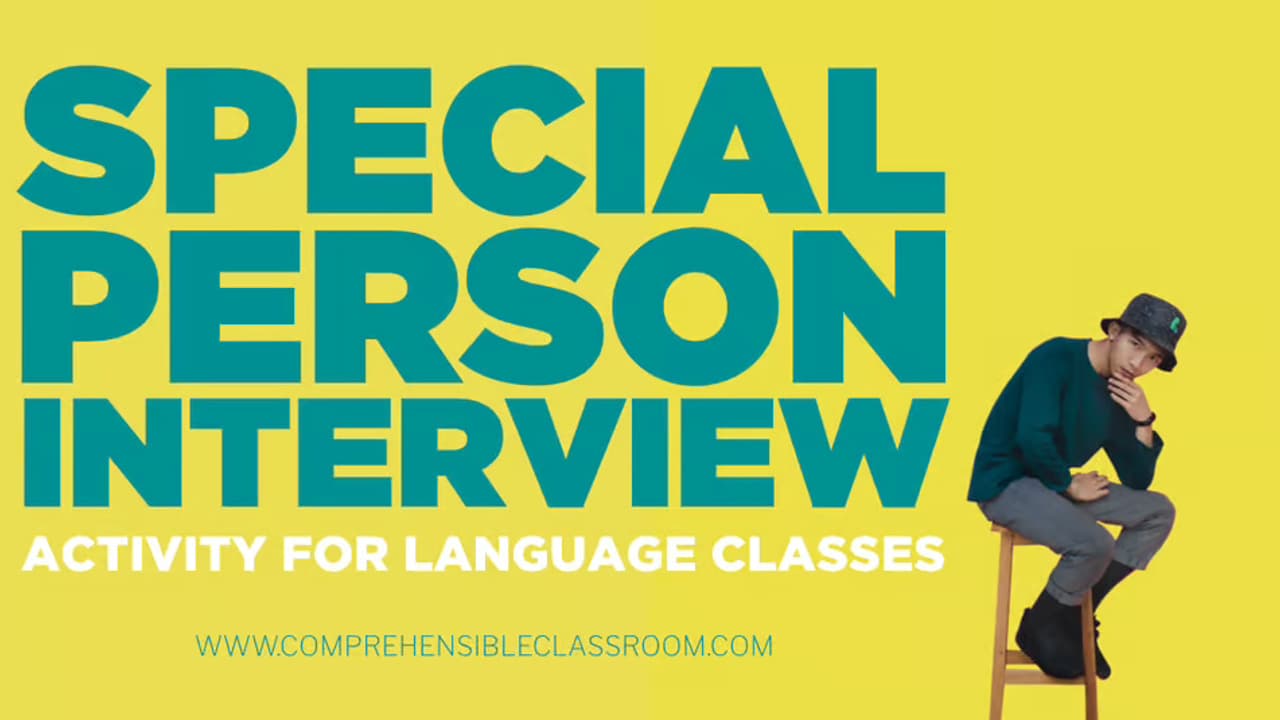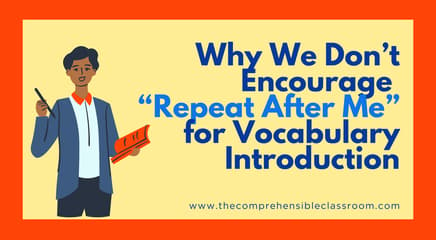Special Person Interviews build community. When done well, students find connections with all of their classmates. Teachers learn more about each one of their students, and everyone's voice and presence is valued.
And oh yeah--all the while, students are acquiring language.
What's not to love?

HISTORY OF SPECIAL PERSON INTERVIEWS
As far as I am aware, Special Person Interviews were conceived by Jody Noble. Jody was a Spanish teacher in San Francisco, and she now lives in Oaxaca, Mexico. Jody originally called the strategy "Star of the Day", and each day one of her students would sit on a stool at the front of the room for their moment in the spotlight.
Since then, Bryce Hedstrom has published a wealth of materials (mostly free) to support teachers in implementing this excellent activity, and I typically recommend that teachers use his blog as a starting point to learn more about this strategy.
What IS a Special Person Interview?
During a Special Person Interview, the teacher selects one student to come to the front of the room. I recommend asking for volunteers at first, because a more timid student would likely feel uncomfortable being called to the front of the room and not knowing what to expect. Then, the teacher starts to interview the student about their life and their interests– entirely in the target language. The teacher begins with simple questions like, "What is your name?", "What do you prefer to be called?", and then moves into other things... like, "Who lives in your house with you?", "What is your favorite TV show?", "What is your spirit animal?". Truly, you could ask anything!
As always, it is critical that the teacher support comprehension at every moment of the interview. The student being interviewed must understand the question, and so the teacher might choose to translate some words. When the student wants to respond with an answer that they don't know how to say in Spanish, the teacher can accept an answer in English and then reframe it in Spanish for the student.
It is also important that the other students in the class understand everything. When comprehension breaks down for classmates, problems will arise. It is then that side conversations and snickering will begin, and the entire process and purpose will be undermined. Your entire class must understand everything that is said during the interviews! This is simple, but it is not easy. You can support comprehension for students in your class...
- by telling them what new words and phrases mean in English (I write them on the board).
- by asking circling questions that clarify meaning and allow for processing.
- by going S-L-O-W, both in rate of speech and in moving from question to question.
- by looking for connections with other students through personalized questions; for example, "Who else loves rugby?".
- by using a slideshow with questions and possible answers that you can point to (see mine here in Spanish and in French)
How many questions to ask?
Different teachers do different things, and so I recommend that you give it a try and see what works for you. I have found the most success in asking very few questions. Start with name and preferred name, age and grade, and maybe one or two more interesting questions about interests. (I now have a slideshow in Spanish and in French to help you know what questions you can ask!)
I like to ask the same 'more interesting' questions for a few days in a row, then to ask a different set of more interesting questions with the next bunch of students. It is easy enough to reflect a new, interesting question out to a student that has already been interviewed so that everyone gets a chance to answer the most interesting questions. I don't feel like asking different questions to different students has any negative consequences. This also allows me to avoid asking problematic questions to certain students: for example, I would likely not ask a student if they have a dog if I know that their dog just died.
When to start interviews?
There is no bad time to start interviews– whether you're looking for a way to start the school year or looking for something new to do mid-year, you can never go wrong with La persona especial.
Many teachers launch every course with interviews. I prefer to start Level 1 with SOMOS 1 Unit 1, and then begin sprinkling in Special Person Interviews in week 2 or 3. I think that Special Person Interviews are a great way to start the year in Levels 2+, because they will quickly allow you to see what language your students have acquired and to plan what kinds of content to work with from there. (Many teachers mix Special Person Interviews with the "Went" Card Talk in SOMOS 2 Unit 1.)
What to do after interviews?
Some teachers give their students quizzes or assign free writes in which classmates must respond to questions or write up summaries of the interviews. I think that this could be a fine thing to do, but it's not my preference. Historically, I gave zero assignments in relation to the interviews. One option that I think has great potential is giving students a task that asks them to notice and remember connections that they have with the interviewed student. I now have an activity in the La persona especial / La personne spéciale pack with a task that accomplishes just this!





